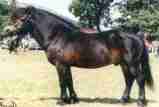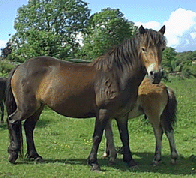The Exmoor

A Unique Pony
The Exmoor Pony is a rare breed of pony which originated
on Exmoor, a desolate area of southwestern Britain. Ponies still run on the moors
and their purity is guarded by TheExmoor Pony Society.
The
Exmoor pony has a number of distinguishing features.
Dun
coloring with dark points and a "mealy" muzzle, as well as mealy coloring
around the eyes and the underbelly.
A unique "toad" eye in which
the heavy top lid gives a hooded appearance.
An "ice"tail, with
a disctinctive fan of short hair at the top
A coat which is virtually double-textured.
In winter it is thick, harsh and almost waterproof; in summer it is sleek and
has a metallic sheen.
A distinctive jaw formation and the beginnings of a
seventh molar, found in no other living equine, but similar to folssils found
from the Pleistocene era.
A Versatile Pony
The height limit for Exmoor
ponies is 12.2 hands for mares and 12.3 hands for stallions. Their good sloping
shoulders, short back and powerful quarters make them good riding ponies. They
are, of course, excellent for children, but their outstanding strength makes them
capable of carrying adults. They are also excellent harness ponies, easy to match
into teams.

History
The
Exmoor pony is named for the district in England from which it is native. The
Exmoor district is partly in the county of Somerset and partly in Devonshire.
There is a National Park, approximately 265, comprising of a wild tract of land
bordering on the Bristol Channel. All of the Royal Forest is in Somerset, and
Badgeworthy Water forms part of the county boundary, but nearly half of the area
which is designated as Exmoor National Park lies in Devon. The terrain is a high
wind-swept plateau or moor, elevation 1500 feet, and it is covered with heather.
This harsh climate has formed a pony uniquely adapted to the environment.
Although there is a certain
amount of controversy about its origins, there seems to be little doubt that the
Exmoor pony may be considered as an indigenous breed to Britain. All of the sub-species
of Equus migrated to the British Isles, none originated in these isles. The Exmoor
is believed to be the descendant of the Plateau/Celtic, otherwise called North
Atlantic pony, which was subsequently used by the Celts as pack horses, and for
pulling their war chariots. Others believe that this pony crossed overland into
Cornwall from Europe when Great Britain was still attached to continental Europe.
There exist Roman carvings in the West Country of chariots pulled by ponies which
resemble today's Exmoor.
After
Roman invasions, the South West area of England was left mostly uninhabited except
for the ponies. Outwardly these ponies seem unchanged from the first British wild
ponies. Color and markings resemble those of primitive horses as the Wild Ass
and Przewalski's Wild Horse. Significant features in the bones reveal further
clues as to these ponies being the surviving relic of the original native pony.
Dental studies of the Exmoor shows the same arrangement of teeth and jaw structure
as those ponies of many thousands of years ago. And fossils of Celtic ponies found
in Alaska also have these same features. The Exmoor is the modern equine which
bears these characteristics. Comparisons of leg bones from the Exmoors also remarkably
match those of the prehistoric findings. Other horses and ponies throughout Europe
through the centuries have been altered so radically by man's influence, both
in accidental and deliberate cross-breeding and blending.
The
Exmoors have received no significant introduction of outside blood throughout
the centuries, and are the surviving representative of Britain's wild pony. Some
people find it difficult to accept the fact that this small group of ponies have
escaped the melting pot of horse breeding in Britain, remaining a natural animal.
This is explained in the history of the district and its people. Exmoor is very
remote and the people were strong in traditions of the moor, and without much
contact with the outside world. These people were resistant to change and had
an early concept of conservation, thus saving the Exmoor Pony in its true form.
The Exeter Doomsday
Book (or Doomesday Book, a record of an official survey of England made in 1085-1086)
contains the earliest mention of ponies on Exmoor. Seven wild horses were listed
as owned by a man named Roger, living at Hernole (in the Parish of Carhampton).
This survey was ordered by William the Conqueror, possibly to help in the collection
of taxes for the Danegeld, an English national land tax. Though the exact purpose
of the book is disputed, it became the official register of land ownership, and
contain many useful incidental details.